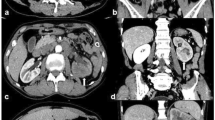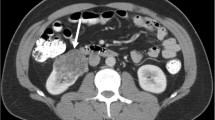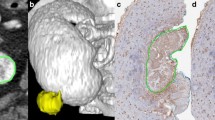Abstract
Background
Clear cell renal cell carcinoma (CCRCC) comprises 70%–80% of RCCs. The World Health Organization/International Society of Urology Pathology (WHO/ISUP) classification is the most important prognostic factor for CCRCC. By evaluating the variations of tumor microvascular density, contrast-enhanced ultrasound (CEUS) can noninvasively predict the WHO/ISUP grade of CCRCC, and provide the appropriate treatment plan before clinical operation.
Methods
In this study, we used CEUS features to analyze 116 CCRCC cases and assess the value of correlation between each indicator and CCRCC WHO/ISUP grading.
Results
When compared to high-grade (WHO/ISUP grade III/IV) tumors, low-grade (WHO/ISUP grade I/II) tumors had reduced relative peak intensity (ΔPI) (P = 0.021), relative area under the curve (ΔAUC) (P = 0.019). However, the frequency of incomplete pseudocapsule (P = 0.021) was significantly higher in high-grade tumors. A cut-off value of mean diameter > 5.5 cm, ΔPI > 304 × 10–3, ΔAUC > 350 × 10–3 allowed identification of high-grade tumors with an area under the curve (AUC) of 74.6%, 71.7%, 70.7%, respectively (95% confidence interval).
Conclusions
The features of CEUS are effective for differentiating high-grade tumors from low-grade tumors, thus CEUS can be considered an acceptable method for the preoperative assessment of tumor grade.





Similar content being viewed by others
Data availability
The authors confirm that the data supporting the fingdings of this study are available within the article.
References
Siegel RL, Miller KD, Jemal A (2017) Cancer statistics. CA Cancer J Clin 67(1):7–30
Srigley JR, Delahunt B, Eble JN et al (2013) The international society of urological pathology (ISUP) Vancouver classification of renal neoplasia. Am J Surg Pathol 37(10):1469–1489
Khor LY, Dhakal HP, Jia X et al (2016) Tumor necrosis adds prognostically significant information to grade in clear cell renal cell carcinoma a study of 842 consecutive cases from a single institution. Am J Surg Pathol 40:1224–1231
Kazmierski B, Deurdulian C, Tchelepi H et al (2018) Applications of contrast-enhanced ultrasound in the kidney. Abdom Radiol. https://doi.org/10.1007/s00261-017-1307-0
Hong CL, Liang F, Lin C et al (2020) The independent indicators for differentiating renal cell carcinoma from renal angiomyolipoma by contrast enhanced ultrasound. BMC Med Imaging 20:32
Han D, Yu Y, Yu N, Dang S, Wu H, Jialiang R, He T (2020) Prediction models for clear cell renal cell carcinoma ISUP/WHO grade: comparison between CT radiomics and conventional contrast-enhanced CT. Br J Radiol 93(1114):20200131. https://doi.org/10.1259/bjr.20200131
Zhao Z, Li Y (2013) Advances in epidemiology of renal cell carcinoma [J]. Shandong Med 53(7):95–97
Chen C, Kang Q, Xu B et al (2017) Differentiation of low-and high-grade clear cell renal cell carcinoma: tumor size versus CT perfusion parameters. Clin Imaging 46:14–19
Renal cell carcinoma (2010) Contrast enhanced ultrasound features relation to tumor size. Eur J Radiol 73(1):162–167
Coy H, Young JR, Pantuck AJ, Douek ML, Sisk A, Magyar C, Brown MS, Sayre J, Raman SS (2020) Association of tumor grade, enhancement on multiphasic CT and microvessel density in patients with clear cell renal cell carcinoma. Abdom Radiol (NY) 45(10):3184–3192. https://doi.org/10.1007/s00261-019-02271-1
Bertolotto M, Cicero C, Perrone R et al (2015) Renal masses with equivocal enhancement at CT: characterization with contrast-enhanced ultrasound. AJR Am J Roentgenol 204(5):W557–W565
Sun D, Wei C, Li Y et al (2016) Contrast-enhanced ultrasonography with quantitative analysis allows differentiation of renal tumor histotypes. Sci Rep 6:35081
Stock K, Kubler H, Maurer T et al (2017) Innovative ultrasound: Contrast-enhanced ultrasound of the kidneys. Aktuelle Urol 48(2):120–126
King KG, Gulati M, Malhi H et al (2015) Quantitative assessment of solid renal masses by contrast-enhanced ultrasound with time-intensity curves: how we do it. Abdom Imaging 40(7):2461–2471
Harvey CJ, Alsafi A, Kuzmich S et al (2015) Role of US contrast agents in the assessment of indeterminate solid and cystic lesions in native and transplant kidneys. Radiographics 35(5):1419–1430
Forsberg F (2010) Can the effect of antiangiogenic treatments be monitored and quantified noninvasively by using contrast-enhanced US? Radiology 254:317–318
Jiang J, Chen Y, Zhou Y, Zhang H (2010) Clear cell renal cell carcinoma: contrast-enhanced ultrasound features relation to tumor size. Eur J Radiol 73(1):162–167. https://doi.org/10.1016/j.ejrad.2008.09.030
Xue LY, Lu Q, Huang BJ, Li CX, Yan LX, Wang WP (2016) Differentiation of subtypes of renal cell carcinoma with contrast-enhanced ultrasonography. Clin Hemorheol Microcirc 63(4):361–371
Acknowledgements
I would like to express my gratitude to all those who helped me during the writing of this thesis. I gratefully acknowledge the help of my supervisor, Ms. Ye Qin, who has offered me valuable suggestions in the academic studies. She has spent much time reading through each draft and provided me with inspiring advice.
Author information
Authors and Affiliations
Contributions
X-QF and QY conceived and designed the study. X-QF wrote the initial version of the manuscript and constructed the figures and tables. FF, H-PZ and Y-FZ acquired and analyzed the data. QY, S-EX, and R-XL contributed to the critical revision of the manuscript, figures, and tables. All authors read and approved the final version of the manuscript.
Corresponding author
Ethics declarations
Ethical approval
The studies involving human participants were reviewed and approved by the ethics committee of Fujian Medical University Union Hospital. Written informed consent for participation was required for this study in accordance with the national legislation and the institutional requirements.
Additional information
Publisher's Note
Springer Nature remains neutral with regard to jurisdictional claims in published maps and institutional affiliations.
Rights and permissions
Springer Nature or its licensor (e.g. a society or other partner) holds exclusive rights to this article under a publishing agreement with the author(s) or other rightsholder(s); author self-archiving of the accepted manuscript version of this article is solely governed by the terms of such publishing agreement and applicable law.
About this article
Cite this article
Fan, X., Fu, F., Liang, R. et al. Associations between contrast-enhanced ultrasound features and WHO/ISUP grade of clear cell renal cell carcinoma: a retrospective study. Int Urol Nephrol 56, 1157–1164 (2024). https://doi.org/10.1007/s11255-023-03774-z
Received:
Accepted:
Published:
Issue Date:
DOI: https://doi.org/10.1007/s11255-023-03774-z




